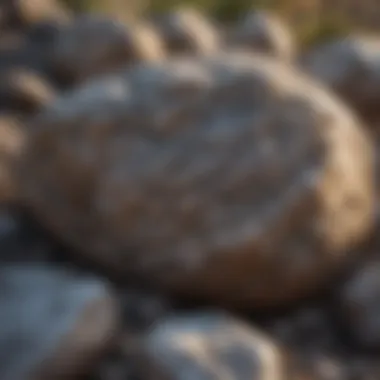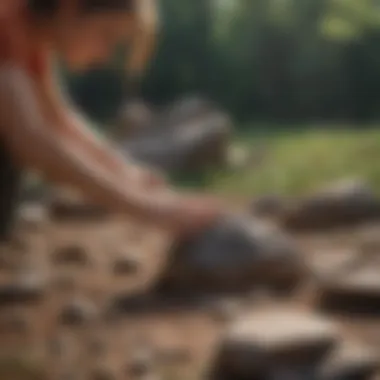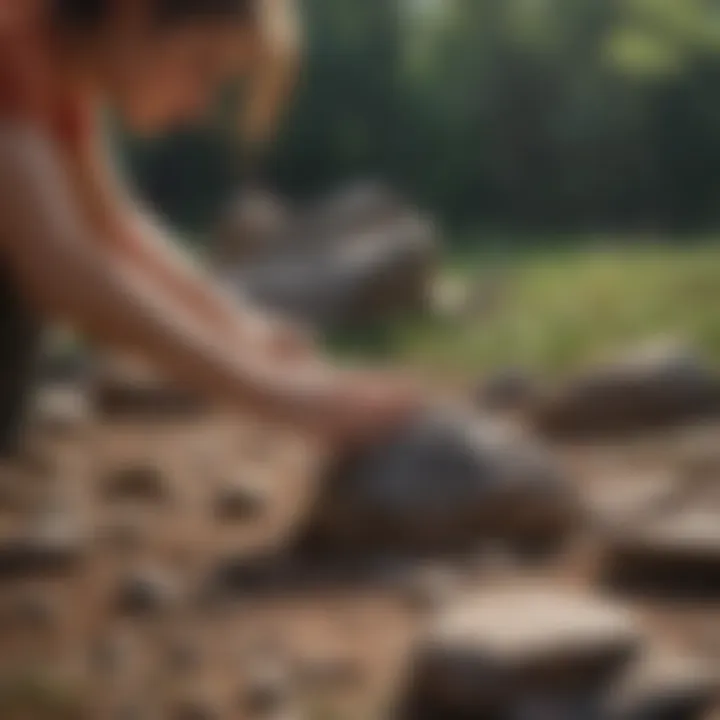The Practicalities of Picking Up Rocks in Your Yard


Intro
Collecting rocks in your yard is more than a simple pastime; it is an exploration of the earth's history. Each stone has a story to tell, reflecting the geological processes that shaped its form. For enthusiasts, the act of picking up rocks is a way to engage with the environment, fostering a connection that transcends mere observation. This article aims to guide you through the practicalities of this rewarding endeavour, discussing various types of rocks you might encounter and the skills needed for effective collection.
Featured Collectible of the Month
Every month, a particular rock type can capture the attention and enthusiasm of collectors. This month, we shine a light on the agate.
Overview
Agates are a variety of chalcedony, consisting primarily of silica. Their fine grain gives them a smooth texture. They are often found in a range of colors, displaying banded patterns and swirls. Commonly discovered in riverbeds or eroded volcanic areas, agates are relatively easy to spot, making them a favorite among amateur collectors. The diversity in appearance provides an endless source of fascination for those seeking out unique specimens.
Historical Significance
Agates have a rich history that spans thousands of years. Ancient civilizations valued agates for their perceived protective properties. They used these stones in amulets and jewelry, believing in their power to enhance the well-being of the wearer. Today, numerous craft artisans still incorporate agates into their work, giving them both aesthetic and functional roles in art and decoration.
Identification Techniques
Successfully identifying and classifying the rocks gathered in your yard enhances the value of your collection.
Visual Characteristics
When you encounter a rock, observe its key features:
- Color: Note the primary hue and any variations.
- Texture: Is it smooth or rough? Look for patterns or layers that signify different minerals.
- Shape: Are the edges sharp, or are they worn down? Natural weathering can provide clues about the rock’s environment.
Resources for Identification
Several resources can assist you in accurately identifying rocks. Books such as "The Rock and Gem Book" by Ronald Bone are valuable for beginners. Online platforms also offer community support. Websites like Wikipedia, Britannica, and forums on Reddit can be useful for quick reference and community engagement.
Using multiple resources for identification can improve accuracy and deepen your understanding of local geology.
Prolusion to Rock Collection
Rock collecting is more than just a hobby; it serves as an entry point to understanding the intricate relationship between nature and human curiosity. This practice is beneficial in numerous ways, revealing not only a connection to the environment but also offering educational opportunities and personal satisfaction.
When you engage in rock collection, you begin to form a deeper appreciation for the geological history underpinning your area. Each collected rock tells a story: of its formation, age, and the natural forces that have shaped the landscape over time. This connection enhances one’s awareness of local ecology and encourages a sense of stewardship toward the environment.
Additionally, for many individuals, this practice is a means of relaxation and mindfulness. The simple act of searching for and collecting rocks can provide a sense of accomplishment, while also breaking the monotony of daily life. It promotes physical activity, as participants often have to venture outdoors to examine their surroundings. This not only benefits physical health but also mental well-being by immersing oneself in nature.
Importance of Rock Collection
Rock collection holds significance for various reasons, ranging from scientific interest to artistic appreciation. Many collectors focus on the aesthetic qualities of rocks and minerals. The appeal of color, texture, and shape can inspire creativity and artistic expression. Moreover, the emotional connection to collected rocks can enhance one's home decor, making collected specimens not just items of interest, but conversation starters.
Additionally, there is a growing interest in the scientific dimensions of rock collecting. Knowledgeable collectors can identify different types of rocks and minerals, thus contributing to geological surveys and local studies. The understanding gained through collection can further inspire educational pursuits, especially for young learners who can engage with the subject matter in a hands-on manner.
Lastly, the ethical implications of rock collection cannot be overlooked. It is important for collectors to be mindful of local laws and regulations regarding rock collecting. Respect for nature and the local environment is central to the practice, ensuring that future generations can also experience the joy of discovering these natural wonders.
Historical Context of Rock Collecting
The history of rock collecting stretches back thousands of years. Ancient civilizations often valued stones for their beauty and utility. For instance, the Egyptians treasured lapis lazuli and other semi-precious stones for both decorative and practical uses. Archaeological findings indicate that various cultures used stones in tools and ceremonial objects, marking the importance of rocks in human innovation.
The modern era saw a significant shift, especially during the 19th century. The scientific community began recognizing the importance of minerals and rocks in understanding Earth's systems. Collectors and geologists started documenting findings more systematically, leading to advancements in geology as a science. This period included the establishment of museums where rock collections were displayed, educating the public about geological diversity.
Today, rock collecting is a popular recreational activity that merges historical appreciation with modern scientific inquiry. The evolution of this practice tells us not only about our planet's history but also about our ongoing quest for understanding and connectivity with the world around us.
Types of Rocks Found in Your Yard
Understanding the different types of rocks you might encounter in your yard is essential for both the novice rock collector and the seasoned enthusiast. Each type of rock tells a unique story about the geological processes that formed them. By recognizing these types, collectors can not only enrich their personal collections but also deepen their appreciation for the local geology. Further, it enhances your skills in rock identification, making the collection process more rewarding.
Igneous Rocks


Igneous rocks are formed from the cooling and solidification of magma or lava. These rocks can be found in various environments, depending on whether they cool beneath the surface or erupt from volcanoes. Common examples include granite and basalt.
Granite, often prominent in areas with a continental crust, is usually coarse-grained with large crystals. It often appears in backyards near areas where natural weathering has exposed it. Basalt, on the other hand, has a finer texture and can be found in places where ancient volcanic activity was prevalent. To identify igneous rocks, look for their crystalline texture and mineral composition.
Sedimentary Rocks
Sedimentary rocks form through the accumulation and compaction of mineral and organic particles. These rocks often reveal layers that tell the history of the environment in which they formed. Common examples include sandstone, limestone, and shale.
Sandstone is typically found in areas that were once covered by water. Its grains are often easy to distinguish by touch. Limestone can be identified by its reaction to vinegar, indicating the presence of calcium carbonate. Shale, composed of fine particles, can sometimes appear as flat, thin layers. The presence of fossils embedded within these rocks can enhance their educational value, providing insight into the ecological history of the area.
Metamorphic Rocks
Metamorphic rocks arise from existing rocks subjected to high heat and pressure. This transformation can alter mineral composition and physical properties. Common examples include schist, gneiss, and marble.
Schist is characterized by its shiny appearance due to the presence of mica. Gneiss features distinct banding, making it visually striking. Marble, a metamorphosed form of limestone, is often prized for its aesthetic appeal, particularly in landscaping. When collecting metamorphic rocks, observe the texture and layering as indicators of their formation process.
Understanding the types of rocks in your yard provides insights into the local geology, enriching both your collection and knowledge about the Earth itself.
Identifying Rocks
Identifying rocks is an essential part of rock collecting. It enables collectors to appreciate not only the aesthetic beauty of the stones but also their geological significance. Knowing how to identify different rock types can enrich the collecting experience. The process involves recognizing various characteristics like texture, color, hardness, and mineral composition. Successful identification can lead to a deeper understanding of local geology and the history behind the formations found in your yard.
Basic Identification Techniques
There are several basic techniques one can use to identify rocks accurately. Understanding these techniques allows collectors to classify and evaluate their finds more confidently.
- Visual Inspection: Start with a careful look at the rock's surface. Examine the color, patterns, and grain size. Igneous rocks often appear shiny with visible crystals, while sedimentary rocks may show layers.
- Touch and Feel: The texture can reveal information about a rock's type. Smooth textures could indicate sedimentary stones, whereas rough ones may signal igneous or metamorphic rocks.
- Hardness Test: Use the Mohs Hardness Scale. Scratch the rock with a known hardness mineral (like a fingernail for 2.5 or a copper penny for 3.5). This provides insight into its hardness and type.
- Weight and Size: Heft your rock. Some rocks, like basalt, are denser than others like pumice, which may float on water.
These techniques form the cornerstone of rock identification and can be practiced by beginners and seasoned collectors alike.
Using Tools for Identification
Tools can elevate the process of rock identification, making it more accurate and informative. Collectors may find the following tools beneficial:
- Hand Lens or Magnifying Glass: This helps observe finer details like crystal structure and mineral grains.
- Rock and Mineral Identification Guide: A book or digital app can assist in matching the collected rocks with images and descriptions of various types.
- Geological Hammer: Useful for breaking rocks to examine their raw inner structure. Caution is needed here; safety goggles are essential.
- Field Notebook: Keeping a record of finds, locations, and observations aids in learning and developing expertise over time.
By combining basic techniques with the right tools, rock collectors can enhance their understanding and enjoyment of the hobby. As they practice these methods, they cultivate a more profound connection to the geological narrative of their environment.
The Collection Process
The process of collecting rocks from your yard is an essential aspect of this hobby. It is not simply about picking up stones but involves a mindful approach. Each step of the collection process yields valuable experiences and insights into local geology. Knowing how to collect effectively not only enhances your collection but also increases appreciation for the earth’s history around you.
Preparing for Collection
Before any rocks can be collected, preparation is important. This means gathering the right tools and setting intentions. A good idea is to have a durable bag or container to store your finds. Tools like a small shovel, a flat-head screwdriver, or a hammer can help in carefully extracting rocks from the ground without damaging them.
Additionally, observe the weather conditions. Collecting during dry weather is preferable, as wet conditions can make the ground muddy and hard to navigate. Check local regulations regarding rock collection as well. In some areas, it may require permits, or certain locations may have restrictions.
Best Practices for Collecting Rocks
Adopting best practices ensures both efficiency and safety in your collection process. First, familiarize yourself with the common types of rocks in your area, as this allows you to make informed decisions about what to collect. When selecting rocks, consider their weight and size. Better to start with smaller stones; they are easier to handle and transport.
It is also advisable to document each rock found, noting where it was collected. This adds educational value and helps in identifying the rock later. Handle each rock gently and avoid collecting rocks from sensitive ecological areas. Preserving the local environment is crucial.
Remember: Collecting rocks should be a sustainable practice. Avoid taking more than you absolutely need and always leave some behind for nature.
Safety Considerations
Any outdoor activity involves certain risks, and rock collecting is no exception. There are various safety considerations to keep in mind.
First, wear comfortable footwear. Hiking boots are ideal as they provide support and protect against uneven terrain. Depending on the environment, consider wearing gloves to protect your hands from sharp edges or rough surfaces of the rocks.
Additionally, pay attention to your surroundings. Always be aware of potential hazards, like rising streams, loose soil, or wildlife. If you are collecting in remote areas, it is wise to inform someone of your location and estimated return time.
"Safety first- always take a friend along for rock collection trips whenever possible."
A comprehensive understanding of safety protocols can help make this hobby enjoyable and risk-free.


Preservation and Care of Collected Rocks
Preserving and taking care of your collected rocks is vital for maintaining their integrity and aesthetic appeal. A well-cared-for collection can provide joy and educational opportunities for years to come. It also allows for better appreciation of the natural beauty and geological history each rock holds. With the right techniques and storage solutions, collectors can ensure their finds remain in great condition.
Cleaning Techniques
Cleaning rocks is an essential step before storing them. It helps remove dirt, debris, and other contaminants that may degrade their appearance. Here are some effective cleaning techniques:
- Rinsing: Simply rinse the rocks in water to remove loose dirt. This method works well for most rock types.
- Scrubbing: Use a soft brush, like a toothbrush, for more stubborn dirt. Be gentle to avoid scratching the surface.
- Soaking: For heavily soiled rocks, soak them in a mixture of water and mild soap for about 15–30 minutes before scrubbing.
- Acid Cleaning: Some collectors use a dilute solution of hydrochloric acid for cleaning calcite or limestone, but be cautious as this can damage other minerals.
Always test cleaning methods on a small, inconspicuous area first. It is wise to avoid harsh chemicals that could harm the rock. After cleaning, rinse thoroughly and let the rocks dry completely before storing them.
Storage Solutions
Proper storage is crucial to preserving the quality of your collected rocks. Here are a few strategies for effective rock storage:
- Display Cases: Invest in a display case made of glass or acrylic. This keeps dust away and allows you to admire your collection.
- Boxes and Bins: Use containers that have dividers to prevent rocks from chipping each other. Whether using wooden boxes or plastic bins, ensure they are lined to cushion the rocks.
- Labels: Keeping track of where you found each rock can be educational. Use labels with the location, type, and any unique characteristics.
- Humidity Control: Rocks can be sensitive to extreme humidity. Store them in a climate-controlled environment to prevent moisture buildup.
Proper care of a rock collection not only maintains its beauty but also enhances its educational value.
In summary, cleaning and storing your collected rocks correctly is essential for preserving their condition and aesthetic charm. It enhances both the personal enjoyment and educational potential associated with rock collecting.
The Educational Value of Rock Collecting
Rock collecting is an activity that extends beyond simple hobbyism. It engenders critical thinking, curiosity, and an appreciation for the environment. Through exploring rocks, individuals gain insight into geological processes and historical contexts. Furthermore, rock collecting can serve as a bridge to more significant educational pursuits, especially for young learners.
Engaging Young Learners
Involving children in rock collecting offers an interactive approach to education. It turns nature into a classroom, allowing young minds to touch, observe, and wonder about their surroundings. By encouraging kids to pick up rocks, they can learn about various types — igneous, sedimentary, and metamorphic. This hands-on experience can spark a lifelong interest in geology.
Activities can include:
- Sorting Rocks: Kids can classify rocks based on texture, color, or shape.
- Field Trips: Visiting local natural sites encourages exploration and discovery.
- Observation Journals: Keeping records of findings help to develop writing skills and scientific observation techniques.
Learning through collection also enhances problem-solving skills. For instance, children may encounter challenges in identifying a rock and need to apply methods learned to figure it out. Engaging with nature not only stimulates educational content but also fosters personal growth in young learners.
Enhancing Curriculum in Schools
Integrating rock collecting into school curriculums offers unique educational benefits. It aligns with science standards while introducing interdisciplinary approaches. Teachers can design lessons that involve geology, art, and environmental stewardship. For example, creating projects around collected rocks can deepen understanding of local geology and history.
Benefits for schools include:
- Hands-On Learning: It promotes experiential education, which has shown to enhance retention.
- Promoting Collaboration: Group rock collecting fosters teamwork and communication among students.
- Local Relevance: Students can study the rocks that are directly linked to their community, making learning more relevant.
Emphasizing the environmental aspect encourages responsible citizenship. Educators can discuss the impact of human activities on rock formations and ecosystems. This creates an opportunity for meaningful discussions on conservation and sustainability, reminding students that protecting natural resources is integral to their education.
Rocks and Local Geology
Understanding the geology of your local area is crucial for rock collectors. It not only enhances the appreciation for the various types of rocks found in your yard but also provides insight into the geological processes that formed them. Local geology can give context to the rocks you gather, explaining their origin and the environmental conditions that influenced their characteristics. This knowledge can enhance your collection's value, both intellectually and aesthetically.
Rocks in your yard may tell stories of ancient landscapes, volcanic activity, or sedimentation processes. By understanding these processes, collectors can better appreciate the uniqueness of their rocks. Recognizing the significance of local geology also allows for a deeper connection with the environment around you.
Understanding Local Bedrock
Local bedrock is the solid rock that lies beneath the soil and loose material. It is significant because it serves as the foundation for all other geological processes in the area. Knowing the composition of bedrock can help identify what types of rocks are likely to be found on the surface. For example, if the bedrock is primarily granite, a collector might expect to find granite boulders or gravel in their yards.
By examining soil samples and bedrock outcroppings, you can create a clearer picture of the geology beneath your feet. This kind of understanding can be the first step in developing a more sophisticated rock collection. Engaging with geological maps can also provide insights into where different types of bedrock exist and their historical context.
Impact of Erosion and Weathering
Erosion and weathering are natural processes that have a direct impact on the rocks you encounter in your yard. Erosion involves the movement of soil and rock material, while weathering refers to the breaking down of rocks into smaller pieces due to various factors such as wind, water, and temperature changes. These processes can significantly change the landscape over time.


The significance of erosion and weathering cannot be understated in rock collecting. They contribute to the diversity of rocks found in your yard. For instance, rocks that were once part of a larger formation may be broken down and scattered through this process. Understanding how these forces work can provide insight into the age and history of the rocks you find.
"Erosion and weathering create a dynamic landscape, with every rock carrying a piece of history."
Furthermore, recognizing the effect of these processes can guide collectors in determining the best times to search for new specimens. After a heavy rainfall or during a windy season, rocks may be more exposed, revealing new finds. Thus, a deeper understanding of erosion and weathering enhances not only knowledge but also the thrill of collecting.
Myths Surrounding Rock Collection
Rock collection carries various beliefs, some are true while others are muddled by misinformation. This section aims to clarify misconceptions that may deter enthusiasts or affect their approach. Debunking myths is crucial as it helps hobbyists and educational institutions engage more meaningfully with geology. Understanding what is fact and what is fiction can enhance one’s experience and promote responsible collecting practices.
Debunking Common Misconceptions
One common myth is that all rocks and minerals can be collected freely. In reality, the legality of rock collection varies by location. Many public lands have specific regulations. Collecting in national parks or protected areas can lead to penalties. Always check local laws before you start.
Another misconception is that collecting rocks is solely an activity for experts. On the contrary, anyone can participate. Knowledge can be gained through practice and research. Beginning collectors can start by identifying common rocks and understanding their properties.
Additionally, some believe that collecting rocks is purely a waste of time. In fact, it can provide educational value and foster a deeper connection with the environment. It encourages observation, patience, and respect for natural resources.
"Rock collecting can be an avenue for understanding local geology and biology."
Another myth suggests that all rocks should be polished for them to hold value. While polished stones are aesthetically pleasing, value in rocks also comes from their rarity, historical significance, or their role in local ecosystems.
Finally, some may think that rock collecting can harm the environment. While inappropriate practices can indeed lead to ecological impact, ethical collecting promotes awareness of local geology. Responsible hobbyists educate themselves on preservation and choose to collect sustainably.
In summary, dispelling myths around rock collecting not only enhances the enjoyment of the hobby but also encourages responsible and informed practices among collectors. Understanding these truths allows for a richer engagement with the earth's materials.
Ethics of Rock Collection
The ethics of rock collection is a significant aspect of any collection endeavor. Understanding the ethical considerations not only fosters respect for nature but also fulfills civic responsibility. When you collect rocks from your yard, knowledge of legal boundaries and environmental implications is crucial. This understanding enhances your experience and promotes responsible practices within the rock collecting community.
Legal Considerations
Before collecting rocks, it is important to be aware of legal implications. Different regions have varied rules regarding rock collection. In many cases, local laws govern land use and natural resource management. Collecting rocks from your own property is usually permissible, but if your yard borders public land or private property, permission may be required. Failing to obtain proper authorization can lead to legal repercussions, highlighting the necessity of understanding the specific regulations in your locality.
To ensure compliance, consider the following:
- Research Local Laws: Familiarize yourself with the regulations governing rock collection in your area. This may include local ordinances, state regulations, or federal laws related to wildlife protection.
- Check Property Boundaries: Identify property lines clearly to avoid unintentional trespassing on adjacent land.
- Obtain Necessary Permits: If interested in collecting from protected areas or national parks, be aware that permits may be required.
- Respect Private Property: Always ask for permission before collecting rocks from someone else's land, as respect for property rights is crucial in maintaining good relationships with neighbors.
Environmental Responsibility
When collecting rocks, environmental stewardship is a vital consideration. The act of gathering rocks, while seemingly benign, can have ecological consequences. Understanding how to minimize your impact contributes to sustainable practices.
Consider the following aspects:
- Avoid Disruption: When picking up rocks, take care not to disturb the local ecosystem. Leaving habitats intact ensures the well-being of flora and fauna.
- Collect Selectively: Aim to only collect excess rocks. Over-collection can lead to soil erosion and habitat degradation.
- Recycle or Upcycle: After your collection, consider how to use the rocks in ways that benefit your garden or landscape instead of discarding them.
- Educate Others: Sharing knowledge about responsible rock collection can inspire others to act ethically, promoting a culture of environmental awareness.
"Ethics in rock collection is about ensuring that our passion for nature does not come at its expense."
In summary, practicing ethical rock collection involves understanding the legal framework and remaining environmentally conscious. Engaging with these principles enriches the experience for both collector and community. It informs the broader discourse around natural resource stewardship, making every gathering a thoughtful endeavor.
End
Rock collection offers not just an engaging hobby, but also a profound connection to the environment. This article has highlighted essential aspects of collecting rocks in your yard, from identifying various types of stones to understanding local geology. The conclusions drawn emphasize that this simple practice can extend beyond personal gain and serves educational purposes and environmental awareness.
When individuals gather rocks, they often develop a greater appreciation for the natural world. Such interactions can spark curiosity and enable informed discussions about geology, erosion, and local ecosystems. Moreover, the ethical considerations involved in rock collection call for a responsible approach to ensuring that the practice is sustainable and thoughtful.
Summary of Key Points
- Rock collecting promotes a deeper appreciation for nature and geology.
- It involves understanding the types of rocks and how to identify them effectively.
- The process includes careful collection methods and ethical guidelines that ensure environmental responsibility.
- Educational implications are significant, providing opportunities for learning both in informal and formal settings.
Future Directions in Rock Collecting
As interest in rock collecting continues to grow, several directions emerge for enthusiasts. First, community rock clubs may rise, promoting local engagement and sharing knowledge among collectors. These groups could also host educational sessions focused on geology and preservation.
Second, digital platforms can enhance the experience. Online forums such as reddit.com offer spaces for collectors to share findings, seek advice, and discuss best practices. Collaborations with educational institutions may lead to workshops aimed at integrating rock collecting into school curriculums, thus inspiring younger generations.
Lastly, advancements in technology could lead to the creation of mobile apps facilitating rock identification and educational content on geology. Such innovations would streamline the learning process and make rock collecting more accessible. Ultimately, the journey of picking up rocks in one’s yard holds countless opportunities for enlightenment and engagement with the earth's geological narrative.



